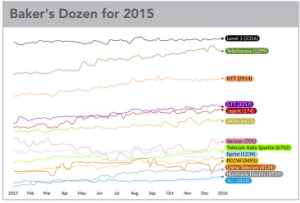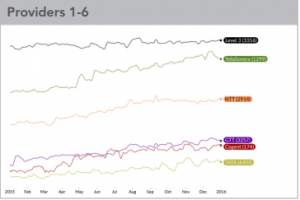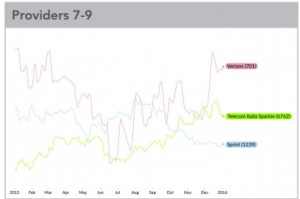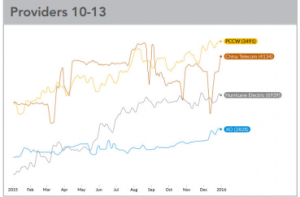A Baker’s Dozen, 2015 Edition
Every year, The Dyn Research Report releases their annual “Baker’s Dozen” edition that lists the top 13 global internet providers. This is done based on their critical insight by what each provider’s statistics reflect. VPLS works directly with 6 out of 13 of these on their list: Level3, China Telecom, PCCW, Hurricane Electric, Tata, and Cogent.
According to the 2015 DYN Research Report, because of Level 3’s decision to integrate Global Crossing’s old network into AS3356, which was referred to as a “global colossus” back in 2011, it was able to acquire new customers based on its rising AS-oriented score. Level 3’s growth increase by almost 10% was due to its extensive customer base which includes China Mobile, Vietnam’s Viettel, and Orange Egypt (Mobinil), formerly LINKdotNET. It has been said that “the next five global providers would have to merge to rival the new Level 3’s score.” Recently, however, TelaSonera outranked Level 3 because of Level 3’s loss of customers that consist of Global Cloud Xchange (a subsidary of Reliance Communications), Taiwan’s Digital United, and Turk Telekom, who, among others, moved to NTT.
China Telecom’s unpredictable rankings are caused by its incestuous routing it has with local competitors. Other variables that affected China Telecom’s score was its fundamental changes relative to transited prefixes from its competitor, China Unicorn. On the other hand, they are looking to target the South African and Brazilian markets.
Hurricane Electric was consistent with its steady growth throughout 2015; Tata is number 6 on the list who proved to be a big winner due it transiting prefixes from Canada’s Telus; and finally Cogent beat out GTT for the number four spot.
Being recognized on the yearly Dyn Research Report is a big deal because the methodology that they use to determine each ranking is by how it compares to their own high-performing authoritative DNS network that uses strategically placed sites and a carefully engineered anycast that provides the ability to monitor the capabilities of the servers all over the world. Ultimately, the purpose of the “Baker’s Dozen” report is to show consumers who performs best on a global scale.





![]()
